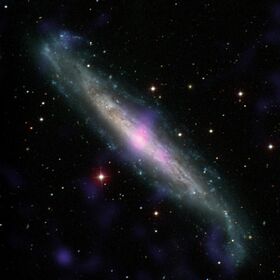Astronomy:NGC 1448
| NGC 1448 | |
|---|---|
 NGC 1448 by NuSTAR and the Chandra X-ray Observatory | |
| Observation data (J2000 epoch) | |
| Constellation | Horologium |
| Right ascension | 03h 44m 31.9s[1] |
| Declination | −44° 38′ 41″[1] |
| Redshift | 1168 ± 2 km/s[1] |
| Distance | 56.5 ± 7.6 Mly (17.3 ± 2.3 Mpc)[1] |
| Apparent magnitude (V) | 10.7 |
| Characteristics | |
| Type | SAcd [1] |
| Apparent size (V) | 7.6′ × 1.7′[1] |
| Other designations | |
| NGC 1457, PGC 13727[1] | |
NGC 1448 or NGC 1457 is an unbarred spiral galaxy seen nearly edge-on in the constellation Horologium. It is at a distance of 55 million light years from Earth. It was discovered by John Herschel in 1835.
From the spectral analysis of SN 2001el, over a dozen diffuse interstellar bands were discovered in NGC 1448 – one of the few cases that these bands were observed outside of the Milky Way. However, the bands were significantly weaker at SN 2003hn.[2]
In January 2017 it was announced that evidence for a supermassive black hole in NGC 1448 had been found in the center of the galaxy.[3]
The galaxy belongs to the NGC 1433 group,[4] part of the Doradus cloud of galaxies.
Supernovae
Six supernovae have been discovered in NGC 1448: SN 1983S (type II, mag. 14.5),[5] SN 2001el (type Ia, mag. 14.5),[6] SN 2003hn (type II, mag. 14.1),[7] SN 2014df (type Ib, mag. 14),[8] SN 2020zbv (type IIP, mag. 18.8),[9] and SN 2021pit (type Ia, mag. 12.3).[10]
Gallery
NGC 1448 taken by the Hubble Space Telescope's Wide Field Camera 3.[11]
References
- ↑ 1.0 1.1 1.2 1.3 1.4 1.5 1.6 "NASA/IPAC Extragalactic Database". Results for NGC 1448. http://ned.ipac.caltech.edu/cgi-bin/nph-objsearch?objname=NGC+1448.
- ↑ J. Sollerman; N. Cox; S. Mattila; P. Ehrenfreund; L. Kaper; B. Leibundgut; P. Lundqvist (January 2005). "Diffuse Interstellar Bands in NGC 1448". Astronomy and Astrophysics 429 (2): 559–567. doi:10.1051/0004-6361:20041465. Bibcode: 2005A&A...429..559S. http://www.aanda.org/articles/aa/full/2005/02/aa1465/aa1465.html. Retrieved 16 January 2016.
- ↑ Two monster black holes found lurking in nearby galaxies
- ↑ Dmitry Makarov; Igor Karachentsev (2011). "Galaxy groups and clouds in the local (z~ 0.01) Universe". MNRAS 412 (4): 2498–2520. doi:10.1111/j.1365-2966.2010.18071.x. Bibcode: 2011MNRAS.412.2498M. http://www.sao.ru/hq/dim/groups/galaxies.dat. Retrieved 1 January 2016.
- ↑ Transient Name Server entry for SN 1983S. Retrieved 25 March 2023.
- ↑ Transient Name Server entry for SN 2001el. Retrieved 25 March 2023.
- ↑ Transient Name Server entry for SN 2003hn. Retrieved 25 March 2023.
- ↑ Transient Name Server entry for SN 2014df. Retrieved 25 March 2023.
- ↑ Transient Name Server entry for SN 2020zbv. Retrieved 25 March 2023.
- ↑ List of Supernovae IAU Central Bureau for Astronomical Telegrams. Retrieved 29 December 2015.
- ↑ "Seeing things sideways". https://www.spacetelescope.org/images/potw1711a/.
External links
- NGC 1448 on WikiSky: DSS2, SDSS, GALEX, IRAS, Hydrogen α, X-Ray, Astrophoto, Sky Map, Articles and images
 |


